for Tuberculosis
and Diseases of the Lungs
Tuberculosis
In 1887 it was decided that the Secretary's office and Out-Patients Department in Tottenham Court Road were becoming 'unworthy of the Hospital' and a new purpose-built Out-Patients Department was envisaged. Financial constraints made this impossible. The lease on the building expired but was renewed on a yearly tenancy while an extensive search for new premises was undertaken. In 1891 the Out-Patients Department moved to new premises at 41 Fitzroy Square.
The next block to be built at Mount Vernon - the central block - was officially opened by Princess Christian (the third daughter of Queen Victoria) in July 1893. She also paid off the debt of £3000 owing on the building. The central block contained an entrance hall, a dining room for the patients and more ward accommodation. The Hospital then had 80 beds but, by 1898, only 60 of these were in use because of financial constraints. In 1899 balconies were built on the blocks to enable patients to stay in the open air as part of their treatment. They opened in June 1900, as well as a temporary extension.In 1901 the name of the Hospital was changed to the Mount Vernon Hospital for Tuberculosis and Diseases of the Lungs to avoid confusion with the nearby North West London Hospital. In 1902 a new X-ray apparatus was installed at a cost of £70 to aid in diagnosis. High frequency electrical currents ('D'Arsonvalisation') were used for treatment. This was an early form of electric diathermy. In effect, the patient was gently microwaved; the benefits came from elevation of the deep tissue temperatures. The open-air balconies were removed (maybe for safety reasons) and a temporary marquee erected instead. It had a raised wooden floor, but was open on all sides, and could house 16 male patients.
The eastern block was completed in 1903 and officially opened by the Marquis of Zetland, President of the Hospital. The new block had accommodation for 45 patients, giving the Hospital a total of 140 beds. Mount Vernon House, built in 1800, which had been the residence of the Hospital Secretary, became the Nurses' Home.
In 1902 the Out-Patient premises at 41 Fitzroy Square were again thought to be unsuitable. The building was sold for £3500 and the Out-Patients Department and Hospital offices moved to 7 Fitzroy Square, a larger building which could also accommodate a pathology laboratory. The cost of purchase of the building and alterations came to £3750.
In 1904 a branch of the Hospital opened on a site south of the Rickmansworth Road in Northwood, a district that attracted several hospitals.
In 1908 the Hospital was connected to mains electricity and it was found that better X-ray images were obtained than with the accumulator.
In March 1913, because of financial difficulties caused by the Insurance Act (local authorities were compelled to make arrangements for the treatment of their tuberculous patients), the Hospital governors decided to transfer all services to the Northwood site. In July the entire consultant staff and the majority of the acting staff resigned because of the summary dismissal of two junior consultants at Northwood.The Hampstead building was sold to the Medical Research Committee and Advisory Council in 1914 to establish a National Institute for Medical Research.
At the outbreak of WW1 the building was offered to the War Office for use as a hospital. The War Office, in their turn, offered it first to the Canadian Contingent for use as their No. 1 Canadian Stationary Hospital. The unit, which had been formed at Valcartier on 13th September 1914, had spent just over three weeks at Salisbury Plain before being ordered to take over Mount Vernon. The Hospital required extensive equipment to make it fit for purpose, with overhauling of the plumbing and some structural alterations, including the installation of an operating theatre. The work took two months and was completed on 28th January 1915, when the Hospital was declared ready to accept patients. On the following day the unit received orders to proceed overseas. On 31st January it embarked at Southampton, together with No. 1 Canadian Clearing Station, to sail to Boulogne, where it opened up at Honeault Camp at Wimereux.
In March 1915 the War Office assigned the Hospital to the Army, and it became The Military Hospital, Hampstead. Four additional huts, each to hold 25 patients, were built in the grounds of the Hospital. The total patient accommodation was 230 beds. The nursing staff consisted of a Matron, six Sisters (two from the Regular Military Nursing Service and four from the Reserve) and 8 members of a Voluntary Aid Detachment. Convalescent soldiers wore new hospital uniforms - blue coats with white facings, matching trousers and a scarlet tie. In 1916 it became a special army research hospital for the study and treatment of cardiac cases among army personnel. One of its main projects was investigation into effort syndrome, or disorderly action of the heart, commonly known as 'soldier's heart'. By 1917 the premises had become too small for the number of patients presenting themselves and the heart unit moved to the Sobroan Barracks Military Hospital in Colchester.
In December 1917 the Mount Vernon buildings became the Royal Flying Corps Central Hospital. In March 1918 an Air Medical Investigation Committee was established to investigate the problems of special disabilities associated with flying, especially anoxaemia (oxygen deficiency) caused by flying at high altitudes.
Flying cadets applying for commissions were examined by Royal Flying Corps Boards at the Hospital, especially eyesight tests (concealed hypermetropia - farsightedness - was a serious obstacle to efficient landing), the condition of the cardiovascular system (changes in pulse rate after exercise), the nervous system (absence of tremor), muscular ability (carrying out successfully balancing objects in unstable equilibrium at arm's length) and vestibular stability (testing the gait after rotation in a chair). Medical examination also include 'habits' - a habitual excessive use of alcohol was a sufficient cause for rejection, and a careful record was made of the number of cigarettes smoked daily and whether they were inhaled; games and sports; occupation; illnesses; family history; heart; pulse; thorax; abdomen; nervous system and mentality. Cardiovascular debility was one of the most frequent causes of rejection, as was nervous instability. Invalid officers also attended the Boards for physical examination to ascertain whether they were fit to return to their units.
In 1919 the Hospital moved to Avenue House in Finchley, but the National Institute for Medical Research continued its work in various locations in London until 1920, when it returned to Mount Vernon after the Military Hospital closed and the buildings had been refitted for laboratory work.
Present status (September 2009)
The National Institute for Medical Research was renamed the Medical Research Council in 1920. It remained in the Mount Vernon Hospital buildings until 1950, when most of its departments moved to a purpose-built institute in Mill Hill. The remainder stayed at Mount Vernon until the work on biological standardization became independent in 1972 as the National Institute for Biological Standards and Control.
In 1980 the Institute moved to the site of the former Clare Hall Hospital.
The Mount Vernon Hospital buildings have been converted into luxury apartments.
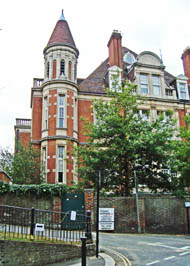
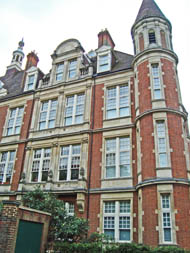
The central block as seen from the south (left) and the north (right).
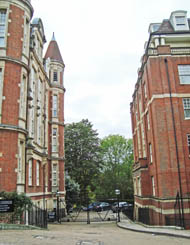
The north block is shown on the left and the central block on the right.
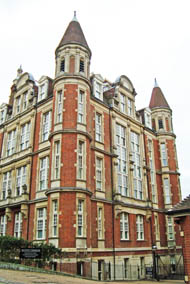
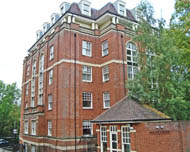
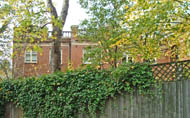

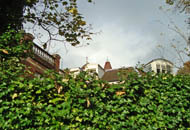
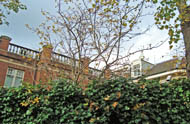
The back wings of the former Hospital are barely visible from Mount Vernon.
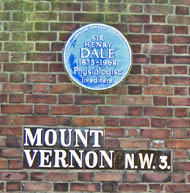
A blue plaque commemorating the physiologist, Sir Henry Dale (1875-1968), who lived at Mount Vernon House.
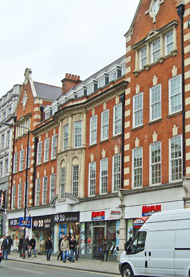
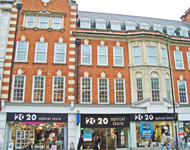
The site of the first Out-Patients Department of the Hospital at 216 Tottenham Court Road from 1861 until 1891.
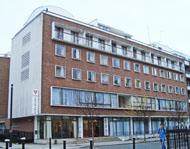
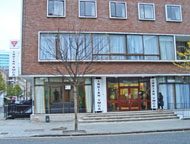
41 Fitzroy Square, the second site of the Out-Patients Department from 1891 until 1902, is on the corner of Grafton Way and Charlotte Street. The site has been redeveloped and is now the Indian YMCA. This section of Charlotte Street was once named Russell Place.
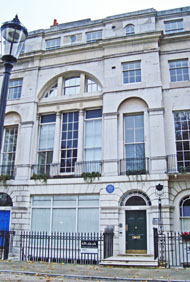
The third Out-Patients Department from 1902 until 1932 at 7 Fitzroy Square, once the home of the artist Sir Charles Eastlake.
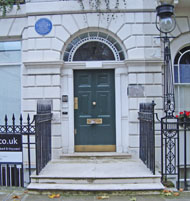
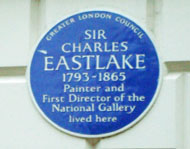
Mount Vernon, George's Washington's home in the United States, is also named after a military man - Admiral Edward 'Old Grog' Vernon (1684-1757), a British naval hero, but there is no connection between the two.
(Author unstated) 1913 Mount Vernon Hospital, Hampstead. British Medical Journal 2(2741), 77.
(Author unstated) 1917 List of the various hospitals treating military cases in the United Kingdom. London, H.M.S.O.
Tunnicliffe FW, Whiting AJ 1913 Mount Vernon Hospital, Hampstead. British Medical Journal 2(2762), 1514-1515.
Johnston C 1913 Mount Vernon Hospital, Hampstead. British Medical Journal 2(2761), 1458.
Parkinson J 1941 Effort syndrome in soldiers. British Medical Journal 1, 545-549.
Wade C 1984 The Streets of Hampstead. London, Camden History Society.
http://archiseek.com
http://circ.ahajournals.org
http://digital.library.upenn.edu
http://rcnarchive.rcn.org.uk (1915)
http://thevirtualtourofhampstead.co.uk
www.1914-1918.net
www.awm.gov.au
www.british-history.ac.uk
www.dailymail.co.uk
www.euroflogroup.co.uk
www.flightglobal.com
www.geograph.org.uk
www.hampsteadheath.net
www.ukpmc.ac.uk
Return to home page